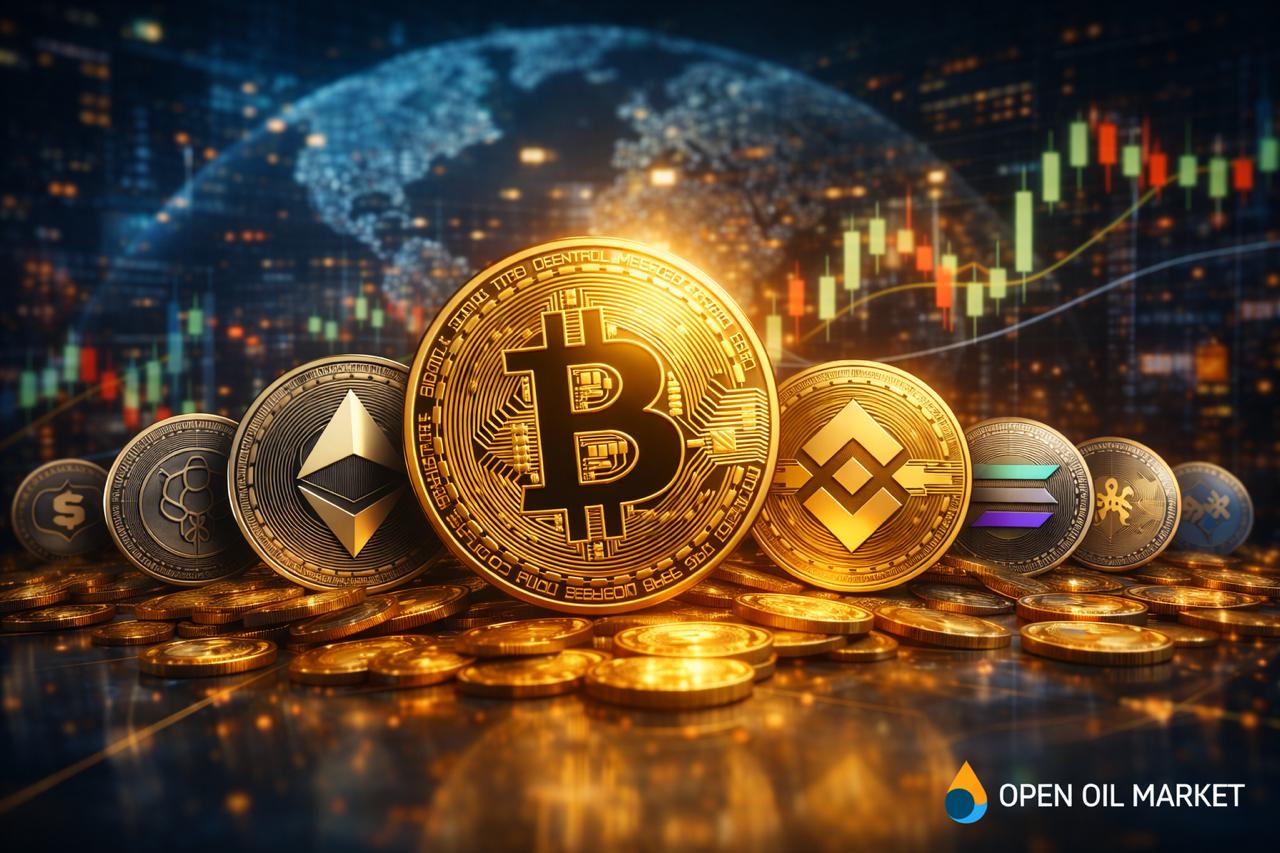
The Cryptocurrency Market Recovers After Correction: Bitcoin Surpasses $115,000 Again, Ethereum Rises, and Altcoins Strengthen. Institutional Investments and Regulation Continue to Support Demand. Top 10 Largest Cryptocurrencies as of October 14, 2025.
As of the morning of October 14, 2025, the cryptocurrency market has stabilized after a spike in volatility at the end of last week. Bitcoin has reclaimed much of its recent drop, hovering around the $115,000 mark, bringing the total market capitalization back to approximately $4 trillion. Following Bitcoin, leading altcoins, especially Ethereum, have exhibited confident growth, with most of the top 10 digital assets trading back in the "green zone." Investors, including institutional ones, have rekindled capital inflows into cryptocurrencies amid improved sentiment, ongoing interest in crypto ETFs, and a reduction in short-term macroeconomic risks.
Bitcoin Rebounds
Over the weekend, Bitcoin (BTC) experienced a sharp price drop; during what is termed a "flash crash," the leading cryptocurrency briefly fell from approximately $126,000 to around $110,000. The catalyst for the sell-off included external factors such as heightened trade risks between the US and China following President Donald Trump's announcement of new tariffs. Thin weekend trading volumes and widespread margin liquidations exacerbated the decline. However, as the situation clarified and amid sustained fundamental demand, Bitcoin quickly rebounded. Currently, BTC is trading around $115,000, roughly 3% above levels from the previous day. The market capitalization of Bitcoin is estimated at approximately $2.3 trillion, accounting for about 57% of the total cryptocurrency market. Since the beginning of the year, BTC has gained over 40%, once again outpacing traditional assets (stock indices, gold) and reaffirming its status as "digital gold" for long-term investors.
Experts note that Bitcoin's current recovery relies on the same factors that have driven the market throughout this year. The regulatory environment for cryptocurrencies remains relatively favorable in the US: the Trump administration continues to support the industry (earlier in 2025, the authorities even initiated the creation of a state reserve in BTC and allowed 401(k) pension funds to invest in digital assets, strengthening investor trust). Large public companies are also not shying away from cryptocurrency strategies; for instance, Marathon Digital Holdings reported purchasing an additional 400 BTC this week, capitalizing on the price decline. Such steps by institutional players serve as a positive signal, indicating a readiness to view market dips as opportunities to increase positions.
Ethereum Returns to Growth
The second-largest crypto asset, Ethereum (ETH), has also confidently bounced back alongside Bitcoin. The price of Ethereum has surpassed the psychologically significant level of $4,000 and currently fluctuates around $4,150, which is approximately 8% higher than the weekend's lows. Although the current ETH price is still about 15% below its all-time high of $4,890 set in 2021, the upward trend remains strong. Ethereum still constitutes about 13% of the total market capitalization, bolstered by demand for its smart contract platform and decentralized finance (DeFi) applications.
Analysts attribute Ethereum's resilience to a combination of technological and market factors. Following the network's transition to Proof-of-Stake and the introduction of a fee-burning mechanism, the growth of ETH supply has noticeably slowed, supporting the long-term appreciation of the asset. Institutional interest in Ethereum is also significant; earlier this summer, the first Ethereum spot ETFs were launched in the US, creating a new capital inflow channel. Just in the past few weeks, specialized funds focused on Ethereum attracted hundreds of millions of dollars in investments, reflecting the confidence of major players in Ethereum's prospects. Coupled with the evolving Layer-2 solutions ecosystem and recent network upgrades (such as the latest scaling protocol), this creates a solid foundation for ETH's continued growth.
Among other market leaders is Binance Coin (BNB). The native token of the largest cryptocurrency exchange, Binance, has appreciated by over 15% in recent days, becoming one of the main beneficiaries of the market rebound. Currently, BNB is trading around $1,300 (it was roughly $400 at the beginning of the year), hitting all-time highs. The rapid growth of BNB comes despite ongoing regulatory pressure on Binance in several countries. Recently, the CEO of the exchange, Changpeng Zhao, publicly refuted yet another wave of rumors about issues within the company, reassuring clients of the business's stability. These statements, combined with high demand for Binance services and the expanding BNB Chain ecosystem, have bolstered investor confidence and propelled BNB's price upward.
Altcoins on the Rise
The broader altcoin market is generally showing synchronous growth, reflecting a return of risk appetite. Prices for most major cryptocurrencies in the top ten have increased by 5–10% in the past day, recovering from recent declines even more dynamically than Bitcoin. The total capitalization of altcoins (excluding BTC) has once again surpassed $1.7 trillion, indicating a flow of new funds into the sector. Many top assets are approaching their recent peak values. For instance, Ripple (XRP) has stabilized around $2.60—not far below September's high of approximately $3.30, which was achieved following Ripple's legal victory over the SEC regarding the token's status. With the removal of legal uncertainty, XRP remains in the spotlight for institutional investors, although some price correction is natural after a sharp surge in the summer.
Strong performance is also seen in platform tokens. Aside from the aforementioned BNB, the price of Solana (SOL) is close to its local highs: SOL traded above $190 for the first time since 2022, nearing the $200 mark. Interest in Solana is fueled not only by general market optimism but also by fundamental events: the Solana ecosystem is demonstrating increased activity (the decentralized platforms within the network recorded a weekly trading volume of around $8 billion), and in the US, regulators are reviewing applications to launch the first Solana spot ETF, which raises investor expectations. Additionally, there has been a revival in the sector of meme cryptocurrencies; for example, Dogecoin (DOGE) gained around 10% in a day and is trading near $0.20. While such joke coins remain volatile, periodic attention from the community and high-profile figures (such as Elon Musk) keeps speculative demand alive during market upswings.
Individual mid-level altcoins and tokens in the DeFi sector are showing leading dynamics, indicating increased risk appetite among a segment of investors. For example, the Synthetix (SNX) token, linked to a decentralized derivatives platform, soared more than 90% over the week, reaching a nine-month high. Such sharp price spikes reflect an influx of speculative capital in search of high returns, but experts caution about the fragility of such successes: following a parabolic rise, notable pullbacks often follow. Overall, the broad rise in altcoins affirms the return of optimism to the crypto market and investors’ willingness to reinvest in riskier digital assets.
Regulation and Market Infrastructure
The positive market dynamics are supported by news of advancements in regulation and industry development. In the global crypto business sphere, a significant event was the approval of a Stored Value Facility license by the Central Bank of the UAE for the exchange Crypto.com. This move makes Crypto.com the first platform with such permission in the region and reflects the desire of the Middle East to become a major hub for cryptocurrencies. Accelerated licensing and the influx of crypto companies to the UAE and neighboring jurisdictions (Bahrain, Saudi Arabia) are forming a favorable environment for further market growth in the Middle East.
Progress is also being observed in the legal sphere in Russia. At the Finopolis-2025 forum held on October 9, representatives from the Bank of Russia confirmed plans for the partial legalization of cryptocurrency circulation in the country. The regulator proposed launching a special experimental legal regime from 2026, under which a limited circle of qualified investors would be able to buy and sell crypto assets on domestic platforms. The relevant laws are expected to be developed by next year. While full access for retail investors to this market is not yet being discussed, the mere fact of moving toward regulating cryptocurrency circulation in Russia is viewed by experts as a "shift from a deadlock" in the authorities' position. Combined with the already adopted law on the digital ruble and testing of cross-border crypto settlements, this indicates that even conservative jurisdictions are starting to recognize and integrate cryptocurrencies into the financial system.
Furthermore, the institutionalization of the sector continues in the US and Europe. US regulators are considering expanding the range of available crypto ETFs: in addition to Bitcoin and Ethereum, applications for spot exchange-traded funds linked to assets such as Solana, Cardano, and even some multi-asset index products have been submitted for approval. In the European Union, key provisions of the MiCA regulation came into force in 2025, establishing uniform rules for the circulation of crypto assets across all EU countries. These measures enhance market transparency and investor protection, which could attract even more significant capital to the crypto market in the long term.
Institutional Investments Gain Strength
One of the main trends this year remains the increase in institutional participation in cryptocurrencies. The emergence of spot ETFs for Bitcoin and Ethereum has opened doors for larger investors, and fresh data confirms record inflows of capital. Over the past week, the total investment volume in cryptocurrency funds amounted to about $3.17 billion (according to CoinShares)—one of the highest weekly figures in the history of the industry. The lion's share of the funds came from Bitcoin funds (approximately $2.67 billion), but substantial inflows were also received by altcoin funds. For instance, Solana and XRP attracted $93 million and $62 million over the week, respectively, which, while somewhat lower than the record figures of previous months, still indicates sustained institutional interest in diverse digital assets.
Analysts particularly note the success of the new BlackRock iShares Bitcoin Trust (IBIT). This instrument, launched by one of the world's largest asset managers, managed to accumulate over $2.5 billion in less than two weeks—an unprecedented inflow for a crypto fund in such a short time. Overall, the total asset volume under the management of all spot Bitcoin ETFs and trusts in the US has exceeded $5 billion, signaling rapid growth in institutional demand. Additionally, traditional institutions continue to increase their investments; hedge funds, family offices, and even pension programs are gradually raising their allocations to cryptocurrencies in their portfolios, viewing them as a promising asset class for diversification. According to market participants, the volatility of recent days has not deterred large players; on the contrary, many viewed the correction as a chance to enter the market at more attractive prices.
Experts anticipate that institutional engagement will only increase. This is supported by the expansion of product offerings (besides ETFs for major coins, fund instruments for other top assets are expected), as well as examples of crypto companies entering traditional capital markets. Recently, it was announced that the American exchange Gemini is planning an IPO in 2026—if it occurs, it will be the first instance of a major cryptocurrency platform going public since Coinbase's listing in 2021. Such events reinforce the mutual penetration of the traditional financial sector and the digital asset market, laying the groundwork for further growth in trust from institutional investors.
Market Sentiment and Volatility
The rapid recovery in prices was accompanied by increased volatility, reminding market participants of persistent risks. The Fear and Greed Index for cryptocurrencies, which dipped into fear territory at the peak of the sell-off, has now returned closer to neutral values (~50 points out of 100). This indicates a moderately optimistic sentiment: the panic experienced at the end of last week has shifted to cautious confidence, although the market is still far from euphoria. Analysts emphasize that such sharp fluctuations in sentiment indices and price levels are natural for the developing crypto market.
Statistics on margin position liquidations reflect the scale of recent fluctuations. On the day of the flash crash alone, positions worth over $19 billion were liquidated—the largest single volume this year. The majority was related to excessively leveraged long positions; however, in the following days, there was also a massive "squeeze" of shorts: as prices rebounded, over 100,000 traders betting against growth were forced to close their positions. This "short squeeze" effect further propelled the market upward at the beginning of the week. Experts point out that such episodes expose the vulnerability of players using high leverage: while market liquidity is not yet limitless, even a single negative news item (as was the case with tariffs and China) can trigger a chain reaction of sell-offs and forced position closures.
In this situation, market participants are advised to maintain a balanced approach. Despite the overall positive trend, short-term corrections are inevitable. Current Bitcoin levels ($110–115k) are slightly below significant resistance around $117–120k, and breaking through that could pave the way for new highs (around $125–130k). However, if the negative backdrop intensifies in the near future (for example, if geopolitical conflicts escalate or the US Fed makes stringent statements regarding interest rates), a return of Bitcoin to support levels around $100k could be possible. In any case, experts recommend that investors carefully manage risks: avoid excessive leverage and diversify their portfolios while keeping in mind the high volatility of cryptocurrencies.
Forecasts and Expectations
The majority of analysts agree that the long-term "bullish" trend in the cryptocurrency market remains intact. Despite recent disturbances, fundamental factors—such as growing institutional interest, Bitcoin's limited supply, and technological advancements in the sector—create a foundation for further increases in digital asset value. Major financial organizations are revising their forecasts upwards. For instance, Standard Chartered Bank raised its target price for Bitcoin at the end of 2025 to $200,000 and for Ethereum to approximately $7,500, citing accelerating institutional adoption of crypto assets. A number of independent experts also believe that the peak of the current cycle has not yet been reached, with estimates suggesting possible growth for BTC to $180,000–200,000 and ETH to $8,000–10,000 over the next year, provided that no serious macroeconomic shocks occur.
At the same time, analysts caution that the path to new records will not be linear. Following such a powerful rally as the market experienced in mid-2025, a price consolidation phase—with a prolonged "sideways" range—is likely, during which some speculators will take profits while new investors enter the market on dips. Such a pause will allow for capital redistribution and gathering strength before the next wave of growth. Historical patterns from previous cycles show that after a break, the cryptocurrency market can resume its rise with renewed energy, often reaching significantly higher peaks. Notably, some forecasts that seemed bold a year or two ago have already come true: for example, Pantera Capital projected a rise in Bitcoin to around $120,000 by fall 2025, which has virtually materialized. Overall, assuming a favorable macro environment and continued interest from major investors, experts expect further increases in cryptocurrency market capitalization towards the end of 2025 and into 2026.
Top 10 Most Popular Cryptocurrencies
As of the morning of October 14, 2025, the top ten largest and most popular cryptocurrencies by market capitalization include the following digital assets:
- Bitcoin (BTC) — the first and largest cryptocurrency, the market's dominant asset. BTC is trading around $115,000 after a recent recovery (capitalization approximately $2.27 trillion, ≈58% of the total market).
- Ethereum (ETH) — the leading altcoin and primary smart contract platform. The price of ETH is about $4,150, near multi-year highs; capitalization is approximately $500 billion (≈13% of the market).
- Binance Coin (BNB) — the token of the largest cryptocurrency exchange, Binance, and the native token of the BNB Chain. The value of BNB exceeded $1,300, hitting an all-time high; capitalization is estimated at about $180 billion. Despite regulatory challenges surrounding Binance, the token's widespread use within the exchange ecosystem and DeFi keeps BNB among the leaders.
- Tether (USDT) — the largest stablecoin pegged to the US dollar at a 1:1 ratio. USDT is actively used for trading and storing capital, with a market capitalization of about $170 billion; its price is reliably maintained at $1.00.
- Ripple (XRP) — the token of the Ripple payment network for cross-border settlements. XRP is trading around $2.60; capitalization is approximately $155 billion. Following Ripple's legal victory over the SEC, investors gained clarity regarding XRP's status, which has restored the token's place among the largest cryptocurrencies.
- Solana (SOL) — a high-performance blockchain platform for decentralized applications. SOL is holding around $195 per coin (capitalization ~ $100 billion), returning to levels last seen two years ago. Interest in Solana is fueled by expectations of the launch of an ETF on this asset and the growing number of projects within its ecosystem.
- USD Coin (USDC) — the second-largest stablecoin, backed by reserves in US dollars (issuer — Circle). The price of USDC is maintained at $1.00, with a market capitalization of around $65 billion. USDC is widely used by institutional players and in DeFi protocols due to the transparency and verifiability of its reserves.
- Cardano (ADA) — a platform for smart contracts developed with a scientific approach. ADA is currently trading around $0.75 (capitalization ~ $25 billion) after a volatile period; earlier in August, following ETF expectations, the price of ADA approached $1. The project attracts attention for its active community and plans to launch exchange products based on ADA, supporting long-term growth expectations.
- TRON (TRX) — a blockchain platform for smart contracts and decentralized applications, particularly popular in Asia. TRX is trading around $0.32; market value ~ $30 billion. TRON remains in the top 10 largely due to its network's use for issuing stablecoins (a significant portion of USDT circulates on the Tron blockchain) and the development of multimedia dApps in its ecosystem.
- Dogecoin (DOGE) — the most well-known "meme" cryptocurrency, originally created as a joke. DOGE is keeping close to $0.20 (capitalization ~ $30 billion), reflecting sustained community support and periodic attention from celebrities. Despite high volatility, Dogecoin continues to be among the ten largest coins, demonstrating remarkable resilience in investor interest.




